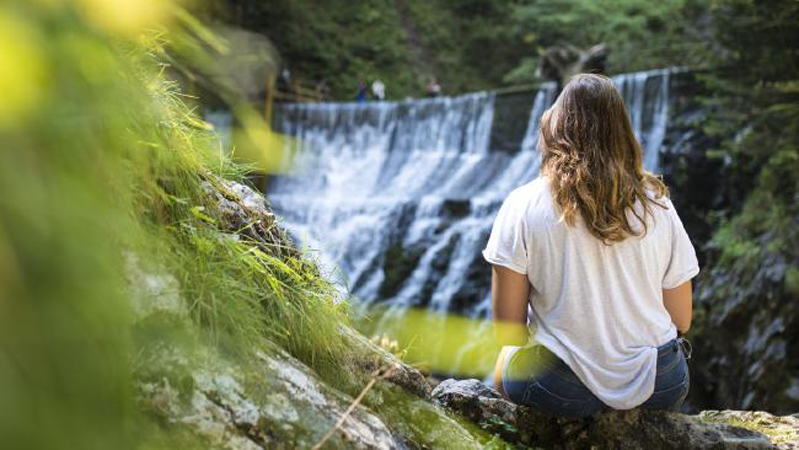
11 Sep Path of Love: A Seven-Day Trip to Your Inner Self
Before arrival we were given the rules: no chocolate, coffee, alcohol, sugar, mobile devices or self-soothing.
When I was a child my father took my sisters and me to a place he called the farm. There was a building on rolling hills, with animals running around in some sort of pen. I remember climbing over the fence to play with the sheep and cows. My little sister and I ran freely around, and while dad was gone we went fossicking. We found a large drum, and my sister lifted the lid. The stench was repulsive. Inside, piled on top of one another, were the tiny heads of lambs. We doubled over in horror.
It wasn’t until a long time later that I realised what the farm was. It was my father’s abattoir. We were petting animals going to their slaughter, and the noises they were making were desperate cries.
At home, meanwhile, in our little blond brick home in the outer suburbs of Melbourne I was discovering a new horror. Many immigrants who would sit at our table, or we at theirs, were Holocaust survivors, including my best girlfriend’s parents — with numbers tattooed on their arms.
That slaughter happened to animals was inconceivable to a child’s mind. But that it happened to millions of people, just 25 years earlier? Not just Jews and homosexuals but disabled children, the frail, infirm and imperfect were herded into gas chambers. While kids on my block frolicked and played in the sun, we saw photos of bodies being shovelled into graves. My friend’s mother was a victim of Nazi doctor Josef Mengele’s experiments when she was pregnant. I knew terrifying things no one should ever know, let alone a child.
And so the question: despite my love of nature and beauty and much happiness in my childhood, how could I tolerate living in such a world of suffering? Smitten with hereditary clinical depression, what were the chances that a super-sensitive child would get through it?
Not high. By my teens I was drinking heavily to numb the pain. But I got through because I found that raw ambition was my true intoxicant. I loved my career as a journalist. I loved losing myself in other people’s stories. I’ve achieved a level of happiness. But in truth, I’ve never felt safe or whole for a day in my entire life.
So when the personal development course Path of Love approached me, I was tempted. I’d truly had enough of the pain. Years of therapy, self-development courses and studying under various Buddhist masters had brought me some peace and meaning, but my greatest enemy — that brutal, critical voice in my head — has never ceased, and in fact become very vocal of late as the world goes into insane self-destruct, triggering my trauma response.
So I decided to go. Path of Love, which started in 1995, is now popular around the world. It blends the wisdoms of Eastern spirituality from where it originated (India) with Western psychotherapy techniques. Some have called the eclectic mix life-changing. Others haven’t been so sure of its lasting impact. I’ve known about it for at least a decade, and remained cynical of what I judged to be excessive self-absorption. But my friend, journalist David Leser, wrote of seeing personal pain, regrets, fears and doubts being “transmuted into unbridled joy”. Other friends talked of being set free from the prison of their minds. One talked of being kinder to others, something I have striven for all my life.
Before arrival we were given the rules: no chocolate, coffee, alcohol, sugar, mobile devices or self-soothing. Trust the process, I was told. Regardless, I smuggled in two blocks of dark Lindt chocolate in my underpants like a drug mule. The seven-day process in a nice Hunter Valley retreat near Sydney was conducted largely in silence outside the sharing room to help us emotionally integrate. There were 32 participants and an equal number of support staff. “I have to find peace now or never,” one person said, echoing us all. I remembered the Talking Heads song Mind: “Time won’t change you/ Money won’t change you … Drugs won’t change you/ Religion won’t change you … I need something to change your mind.” I realised I’d been singing this to my own mind most of my life.
Day one: People from all walks of life and ages told stories of pain, anxiety, bereavement and a cruel inner voice that paralysed them. But despite the tears, many were talking with a strange detachment. A line said so many times had lost its true horror: “I was bashed by my father”; “I was raped by my grandfather”; “My parents died in a car crash when I was 10”.
While confessional, it was skimming the surface — but POL doesn’t allow emotional detachment for long. The premise is we have to release and heal the past, not through words alone but through a process called somatic psychotherapy or body-centred work. It’s about getting into the bones, cells, heart and deeper recesses of the mind, where memories and pains are stored and then repressed. Contemplative and meditative traditions agree. Buddhism calls the process mindfulness or, as Eckhart Tolle puts it, learning to be present. POL fast-tracks this process. It’s mindfulness on steroids. As in “hold on to your hats”, because down you go under the conscious mind at 100km/h into the dark abyss of the psyche. The process tricks the conscious mind and goes under the layers of intellectual defence mechanisms into the body and subconscious mind where secrets are kept from us.
We were asked to randomly choose a “buddy” for support. Mine happened to be a Melbourne psychologist, Sheryl Brosnan. Even though she’s been practising for more than 30 years, she still had aspects of her own trauma she wanted to deal with. Observing the POL structure, she said some of the techniques being used were classic tools for working with complex post-traumatic stress disorder (a form of PTSD concerned with childhood trauma, neglect or abandonment). On a professional level she was impressed, which helped me to trust and let go.
We were divided into small groups, each with its own leader. Mine was Alima Cameron, who runs the program in Australia with colleague Samved Dass, both of whom have worked in psychotherapy for more than 30 years.
“We shut down in life because we feel betrayed, wounded,” she says, “but in order to reconnect to the human family, we must be willing to feel. And it’s very painful and scary to feel terror, shame, rage, sadness, even love. But if you allow yourself, miracles happen.”
Every time I spoke, she brought me back into feeling: “Yes, but how does it feel talking about this? Where is it in your body?” “I don’t know. But how could such a thing as genocide happen? Are we evil as a species or just apathetic to suffering?” Alima: “You use your intellect as an escape. Stop thinking. Feel it …” I resisted. But at night in bed, I felt the shield around my heart slowly cracking.
The bell rang each morning at 6 and we were on the mat by 7, doing “dynamic meditation” to set the body free: wild, joyous dancing; yogic breathing; anger and grief release. In the afternoons, having been provoked by the morning sessions, there was more intense physical catharsis. At nights, meditation, celebration and philosophical teachings. Exhausted on every level, we were given no chance to hide from raw feelings.
Then it happened. During one session I felt the tectonic plates of my soul shift. Words were no longer words, horror was no longer just a concept. I lost a sense of time and space, reliving memories of how it really felt as a child, witnessing such cruelty. Like Munch’s The Scream, I placed my hands over ears and let out a terrifying animalistic cry. The circle of support and love closed tightly around me as I sobbed from a place I never knew existed.
One by one, 32 people broke in those last few days, no longer rational adults justifying the past. They were five years old again, trying to stop a mother being smashed in the jaw or shielding a body from abuse. There was shame, fear and forgiveness. And those things that were not forgivable were accepted and let go.
Though I’d had moments of wanting to run away, I felt the course ended too soon. But with a beautiful ceremony: a prayer to ourselves. It’s now been a month and I’m doing well. Some patterns are finally broken. I still don’t feel safe in this unhinged world of terrorism and nukes. But I do feel safe and whole within myself for the first time. Some traits are still stubbornly set in. Healing is an ongoing process, POL says.
Participants I’ve contacted say they are experiencing ups and downs, relapses and breakthroughs. Brosnan says professionally she found the process profound and transformative.
All my life I’ve wanted to save the world from suffering. But I’ve now realised that it’s the clogged soul that makes genocide and evil possible. That is the solution here: the microcosm within the macrocosm. Not always grand philanthropic acts or political activism. Rather minute by minute, layer by tiny layer, changing ourselves so we can teach or help other living beings, including animals.
Perhaps, one day, the healing might even become globally contagious if we open our wounded hearts and take a risk to walk the path of love.
Ruth Ostrow was a guest of The Path of Love seven-day retreats. For information on this course or others go to pathretreats.com.
Image via: The Austrailan








